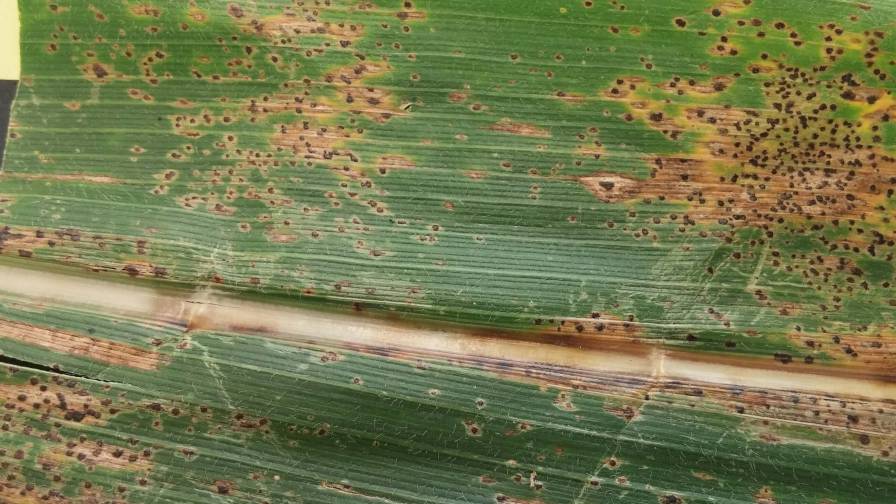Fungicides: Plan for Tar Spot in the U.S. and Cascading Supply Effects in ’22

Tar spot of corn Phyllachora maydis. Photo courtesy: Kiersten Wise, InsectImages.org
U.S. growers and ag retailers will have to contend not only with crop disease management in 2022, but supply challenges that have hit herbicides hard will likely spill over into fungicides as well, writes Jackie Pucci at CropLife.
Significant soybean disease pressure affected fields in many soybean-producing states in ’21, and in corn, tar spot has progressed from an isolated disease to one that has been reported in 14 states, agronomists say.
Nick Groth, Agronomy Service Representative with Syngenta, notes that tar spot not only resurged this past season in Wisconsin since its first unwelcome appearance in 2018, but at a surprising clip in August, just when many assumed they could skate by another year.
“A couple of weeks later we got hit hard. It goes to show it can really sneak up on you with the long latent period it has,” he tells CropLife®. From the time the spore lands on the plant to the time a visual symptom appears, there are 14 days of the disease running rampant in the plant and already taking over.
Tar spot — caused by the fungus Phyllachora maydis and aptly named for the small, raised black spots it forms on the leaf, sometimes mistaken for fly excrement — can cause losses of 50 bushel per acre or more. As such, it is not a “wait-and-see” disease to make an application, he warns, but rather one that demands preventative applications and monitoring.
“We know the inoculum is there, so what it really comes down to now is whether the environment is going to be conducive. The number-one cause for tar spot to proliferate is prolonged leaf wetness,” Groth explains. When the dew sets in before nightfall and doesn’t burn off until 10 a.m. the next day is a prime condition for the disease to form.
For prevention, start with hybrid selection. The past year offered lessons on hybrids that are more susceptible to the disease than others, but Groth says any blanket recommendations on such varieties are not yet fully baked. Instead, work with your agronomist to select the hybrid that is best for your field and look to in-season management. Assess environmental conditions around V12 timing when the corn plant is 6 foot tall. With humid days and nights and prolonged leaf wetness, an early application might be warranted. Plan on following up in 14 days if conditions stay conducive.
“When it comes to tar spot, frogeye leaf spot, or any crop disease, it’s best to get ahead and stay ahead,” adds Kelly Liberator, BASF Technical Marketing Manager, Plant Health and Fungicides. “To prepare for the 2022 season, integrating an effective fungicide application into your corn and soybean crop plans will help ensure protection from these and other yield-robbing diseases. Planned, preventative applications are key to success before disease is established in the field.”
Liberator points out that in soybeans, frogeye leaf spot continues to be a major challenge throughout the U.S. and can reduce yields by up to 30%. QoI (Strobilurin) fungicide-resistant populations have become increasingly prevalent and require growers to carefully select effective fungicides to control the disease.
While diseases can attack soybeans at any time, the greatest impact comes early in the growing season, when seedlings are most vulnerable. Some plants show signs of disease early while others, like those impacted by sudden death syndrome (SDS) or Rhizoctonia, may not show signs until later in the growing season.
“The best way to avoid having sections of fields fall victim to soilborne diseases is to try and prevent the diseases in the first place,” says Nathan Wyss, Market Development Specialist for Corteva Agriscience. “Focus on seed treatment with fungicide. It’s not worth it to skimp on seed treatments to save costs. You’ll pay for it down the road with reduced yields.”





